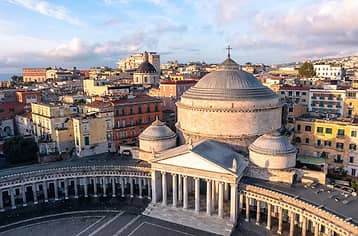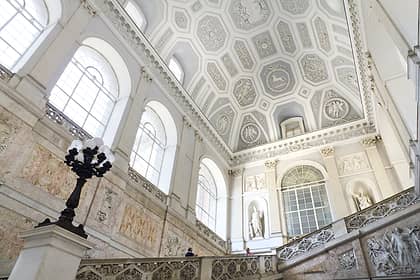Piazza del Plebiscito





Piazza del Plebiscito—or simply “Piazza Plebiscito”, as the Neapolitans call it—is one of the most famous squares in Naples, the city’s elegant heart and backdrop to countless films, TV series, and documentaries. Home to the Royal Palace of Naples, this sweeping square is an ideal spot for an iconic Neapolitan snapshot with the looming peak of Mt. Vesuvius in the background.
A Brief History of Piazza del Plebiscito
A Brief History of Piazza del Plebiscito
Covering roughly 25,000 square meters (270,000 square feet), Piazza del Plebiscito is one of the largest squares in both the region of Campania and the whole of Italy. It is located in Naples’ central San Ferdinando district, about halfway between the historic center of Naples and its waterfront. Via Toledo, one of the city’s main shopping streets, leads directly to the square; locals and visitors stroll the length of this busy thoroughfare (which some Neapolitans still refer to by its former name of Via Roma) to take in its shops, cafes, and historic buildings on their way to the Piazza del Plebiscito.
This area has been an important location in the city’s complex history and politics for centuries. An open square has occupied this space since the mid-1500s, when the ruthless viceroy Don Pedro of Toledo had his palace built here, a residence that was torn down about two centuries later.
The square in its present iteration, however, has only existed since the beginning of the 19th century, when Joachim Murat, king of Naples during the Napoleonic era, commissioned Domenico Fontana to create a large semicircular piazza in front of the Royal Palace.
When first built, the square was simply called Largo di Palazzo. Its name was changed after the plebiscite of 21 October, 1860, held after the expulsion of the Bourbons, which led to the annexation of the Kingdom of the Two Sicilies by the newly formed Kingdom of Italy.
Top Sights in Piazza del Plebiscito
Top Sights in Piazza del Plebiscito

Closed to traffic and opened to the public at the end of the 1900s, Piazza Plebiscito is not only an elegant space where some of the city’s busiest streets converge, but also an open-air museum of architectural treasures and a highlight of most sightseeing tours in the heart of Naples.
The Royal Palace (Palazzo Reale)
The magnificent Palazzo Reale di Napoli lines an entire side of the square. This sweeping palace was in turn residence of the Spanish viceroys, the Bourbon kings, the Austrians, and the French over the 150 years after Charles III of Bourbon decided to make it his seat in 1734.
Until the unification of Italy, the palace was an important setting in the long history of Naples and its people, hosting royalty and nobles of different dynasties and nationalities. The 19 arches on the main facade house the statues of the most famous rulers in the history of Naples, from King Ruggiero II the Norman to Vittorio Emanuele II of Savoy.
Since 1919, the Royal Palace has belonged to the Italian state and today houses one of the city’s top museums. Visitors can marvel at the grand staircase and tour the Royal Apartments, as well as admire the National Library with attached gardens. The sumptuous Teatro San Carlo opera house, overlooking the nearby Piazza Trieste e Trento, is also part of the palace complex.
The Basilica di San Francesco di Paola
Just opposite the Royal Palace, the neoclassical Basilica di San Francesco di Paola is one of the most famous churches in Naples. Its unique 19th-century architecture features a semicircular colonnade that lines the square and a dome similar to that of Rome’s Pantheon.
The Basilica di San Francesco di Paola has long been one of the most popular and beloved local churches for the celebration of weddings, in part because Piazza Plebiscito offers a stunning backdrop for wedding photos. Visitors to the church and square often come across a newly married couple and their guests being photographed in the piazza.
Other Piazza del Plebiscito Highlights
The square is bookended by two identical buildings, Palazzo della Prefettura and Palazzo Salerno (on the side nearest the waterfront). Gran Caffè Gambrinus, one of the oldest and most famous coffee houses in Naples, is just off the square. Stop here for an authentic Neapolitan espresso and a delicious sfogliatella.
Legends and Facts about Piazza del Plebiscito
Legends and Facts about Piazza del Plebiscito

Legend: This landmark square in the heart of Naples is the subject of an ancient legend in Neapolitan popular culture. According to tradition, once a month Queen Margherita of Savoy would pardon any prisoner sentenced to death who could cross the square blindfolded, starting from the entrance to the Royal Palace. To be pardoned, convicts would have to pass between the equestrian statues of Charles III and Ferdinand I which have marked the center of Piazza del Plebiscito since the 18th century (the first work is by Antonio Canova and the latter by the sculptor Antonio Calì).
Crossing Piazza del Plebiscito Blindfolded
It is said that no one ever managed to escape execution, due to a curse cast by the queen herself to mock her prisoners. But since then, Neapolitans and tourists have continued to attempt the feat, closing their eyes and attempting to walk the 170 meters (560 feet) necessary to cross the exact center of the square without running into one of its statues.
The reason that it is so difficult to cross the square blindfolded is probably due to the uneven cobblestone pavement. Queen Margherita, to whom the most famous pizza in history was dedicated, was not known to be particularly violent and, on the contrary, may have even contributed to the abolition of the death penalty in the Kingdom.
Fact: During the Spanish and Austrian viceroyalty, bullfights were held in Piazza del Plebiscito, as recorded in several Neapolitan chronicles dating from the 1500s and 1600s.
Getting to Piazza del Plebiscito
Getting to Piazza del Plebiscito
The square is centrally located in downtown Naples, a short distance from many of the main attractions and easily accessible by public transportation. From the Naples airport, take the Alibus Airport Shuttle and get off at the Maritime Station, then continue on foot to the square.
From the Piazza Garibaldi Stazione Centrale (where the trains to and from Sorrento, Pompeii, and Herculaneum stop), take metro line 1 and get off at the Toledo station, often called the most beautiful subway in the world. The Municipio metro station is also not far away.
The Naples’ cruise terminal and Molo Beverello port—where ferries to and from Capri and the other islands in the Bay of Naples stop—are within easy walking distance to the square. The Calata Porta di Massa ferry port is a bit farther away, about 15 minutes on foot.
Where to Stay Near Piazza del Plebiscito
Where to Stay Near Piazza del Plebiscito
The historic center of Naples is quite compact, so any hotel you choose in Decumani or the Spanish Quarters will be close to the square
If you are staying in the Vomero neighborhood, you can easily reach Piazza del Plebiscito with the Metro line 1, while the large hotels on the Lungomare waterfront are about a 10-minute walk from the square (there is a public elevator to reach the square on Via Acton, but it is not always in operation).
FAQ - Frequently asked questions
How did Piazza del Plebiscito get its name?
The square was renamed after the plebiscite of 21 October 1860, when the Kingdom of the Two Sicilies was annexed to the newly formed Kingdom of Italy after the expulsion of the House of Bourbon.
What is there to visit in Piazza del Plebiscito?
Piazza del Plebiscito hosts several historic buildings of great importance, such as the Royal Palace of Naples, the Basilica of San Francesco di Paola, Palazzo della Prefettura, and Palazzo Salerno.
Who built Piazza del Plebiscito?
The current design of the square was commissioned by Joachim Murat and designed by architect Domenico Fontana.